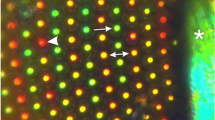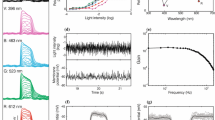Summary
The afocal apposition optics of butterfly eyes was examined from both a geometrical optics and a wave optics point of view. We used several different species of butterfly but put special emphasis on a common Australian nymphalid,Heteronympha merope. From the anatomy of the retina, the optics of isolated components of the eye and the ophthalmoscopy of the intact living eye we derived the following.
-
1.
The proximal part of the crystalline cone behaves as a powerful lens which, according to our measurements of optical power, turns the complete optical system into an afocal telescope with an angular magnification of 6.4 (inHeteronympha). The rhabdom tip lies in the exit pupil of the telescope and is imaged into the cornea with a magnification of 9.1 (in the same species).
-
2.
Using light reflected from the eye's tapetum, we studied the waveguide mode phenomena of the rhabdom. Different butterflies showed either one, two or three waveguide modes, depending on the rhabdom diameter. The mode patterns were observed at four different optical planes: at the cornea, at infinity, at the back focal plane of the corneal lens — which, for this measurement, was optically neutralised — and at the plane of the deep pseudopupil.
-
3.
During light adaptation the closure of the pupil caused the modes to disappear in sequence, starting with the highest order. The behaviour of the fading modes indicates that the pupil acts by absorption rather than by a change of refractive index around the rhabdom.
-
4.
The modes were used to measure the waveguide parameter of the rhabdom, from which its refractive index was deduced to be 1.36.
-
5.
The distinction between near-field and farfield versions of the mode patterns provided further evidence in favour of an afocal optical system.
Two different interpretations of the butterfly optical system are discussed and we present a hypothesis to explain how both afocal apposition and refracting superposition optical systems evolved in insect eyes.
Similar content being viewed by others
References
Bernard GD (1975) Physiological optics of the fused rhabdom. In: Snyder AW, Menzel R (eds) Photoreceptor optics. Springer, Berlin Heidelberg New York, pp 78–97
Cleary P, Deichel G, Kunze P (1977) The superposition image in the eye ofEphestia kühniella. J Comp Physiol 119:73–84
Eltringham H (1919) Butterfly vision. Trans R Entomol Soc Lond 79:1–49
Exner S (1891) Die Physiologie der facettirten Augen von Krebsen und Insecten. Franz Deuticke, Leipzig Wien
Franceschini N (1975) Sampling of the visual environment by the compound eye of the fly: fundamentals and applications. In: Snyder AW, Menzel R (eds) Photoreceptor optics. Springer, Berlin Heidelberg New York, pp 98–125
Franceschini N, Kirschfeld K (1971) Les phénomènes de pseudopupille dans l'oeil composé deDrosophila. Kybernetik 9:159–182
Galbraith W (1955) The optical measurement of depth. Q J Microsc Sci 96:285–288
Gambling WA, Payne DN, Matsumura H, Dyott RB (1976) Determination of core diameter and refractive index difference of single mode fibers by observation of the far-field pattern. Microwaves Opt Acoust 1:13–17
Hateren JH van (1984) Waveguide theory applied to optically measured angular sensitivities of fly photoreceptors. J Comp Physiol A 154:761–771
Hateren JH van (1985) The Stiles-Crawford effect in the eye of the blowfly,Calliphora erythrocephala. Vision Res 25:1305–1315
Hateren JH van, Nilsson D-E (in press) Butterfly optics exceed the theoretical limits of conventional apposition eyes. Biol Cybern
Horowitz BR (1981) Theoretical considerations of the retinal receptor as a waveguide. In: Enoch JM, Tobey FL Jr (eds) Vertebrate photoreceptor optics. Springer, Berlin Heidelberg New York, pp 219–300
Horridge GA, Giddings C, Stange G (1972) The superposition eye of skipper butterflies. Proc R Soc Lond B 182:457–495
Kirschfeld K, Franceschini N (1968) Optische Eigenschaften der Ommatidien im Komplexauge vonMusca. Kybernetik 5:47–52
Kolb G (1977) The structure of the eye ofPieris brassicae L. (Lepidoptera). Zoomorphologie 87:123–146
Kolb G (1978) Zur Rhabdomstruktur des Auges vonPieris brassicae L. (Insecta, Lepidoptera). Zoomorphologie 91:191–200
Kunze P (1979) Apposition and superposition eyes. In: Autrum H (ed) Vision in invertebrates (Handbook of sensory physiology, vol VII/6 A). Springer, Berlin Heidelberg New York, pp 441–502
Land MF (1981) Optics and vision in invertebrates. In: Autrum H (ed) Vision in invertebrates (Handbook of sensory physiology, vol VII/6 B). Springer, Berlin Heidelberg New York, pp 471–592
Land MF (1984) The resolving power of diurnal superposition eyes measured with an ophthalmoscope. J Comp Physiol A 154:515–533
Miller WH (1979) Ocular optical filtering. In: Autrum H (ed) Vision in invertebrates (Handbook of sensory pyhsiology, vol VII/6 A). Springer, Berlin Heidelberg New York, pp 69–143
Miller WH, Bernard GD (1968) Butterfly glow. J Ultrastruct Res 24:286–294
Nilsson D-E (1983) Evolutionary links between apposition and superposition optics in crustacean eyes. Nature 302:818–821
Nilsson D-E, Land MF, Howard J (1984) Afocal apposition optics in butterfly eyes. Nature 312:561–563
Nilsson D-E, Labhart T, Meyer E (1987) Photoreceptor design and optical properties affecting polarization sensitivity in ants and crickets. J Comp Physiol 161:645–658
Pask C, Barrell KF (1980a) Photoreceptor optics I: Introduction to formalism and excitation in a lens-photoreceptor system. Biol Cybern 36:1–8
Pask C, Barrell KG (1980b) Photoreceptor optics II: Application to angular sensitivity and other properties of a lensphotoreceptor system. Biol Cybern 36: 9–18
Pocholle JP (1979) Single mode optical fiber characterisation by the LP11 mode radiation pattern. Opt Com 31:143–147
Ribi WA (1978) Ultrastructure and migration of screening pigments in the retina ofPieris rapae L. (Lepidoptera, Pieridae) Cell Tissue Res 191:57–73
Ribi WA (1979a) Coloured screening pigments cause red eye glow hue in pierid butterflies. J Comp Physiol 132:1–9
Ribi WA (1979b) Structural differences in the tracheal tapetum of diurnal butterflies. Z Naturforsch 34c:284–287
Smakman JGJ, Hateren JH van, Stavenga DG (1984) Angular sensitivity of blowfly photoreceptors: intracellular measurements and wave-optical predictions. J Comp Physiol A 155:239–247
Snitzer E (1961) Cylindrical dielectric waveguide modes. J Opt Soc Am 51:491–498
Snitzer E, Osterberg H (1961) Observed dielectric waveguide modes in the visible spectrum. J Opt Soc Am 51:499–505
Snyder AW (1975) Photoreceptor optics — Theoretical principles. In: Snyder AW, Menzel R (eds) Photoreceptor optics. Springer, Berlin Heidelberg New York, pp 38–55
Snyder AW (1977) Acuity of compound eyes: Physical limitations and design. J Comp Physiol 116:161–182
Snyder AW, Love DJ (1983) Optical waveguide theory. Chapman and Hall, London New York
Snyder AW, Stavenga DG, Laughlin SB (1977) Spatial information capacity of compound eyes. J Comp Physiol 116:183–207
Stavenga DG (1979) Pseudopupils of compound eyes. In: Autrum H (ed) Vision in invertebrates (Handbook of sensory physiology, vol VII/6A). Springer, Berlin Heidelberg New York, pp 357–439
Stavenga DG, Numan JAJ, Tinbergen J, Kuiper JW (1977) Insect pupil mechanisms II. Pigment migration in retinula cells of butterflies. J Comp Physiol 113:73–93
Tuurala O (1954) Histologische und physiologische Untersuchungen über die photomechanischen Erscheinungen in den Augen der Lepidopteren. Ann Acad Sci Fenn A IV 24:1–69
Yagi N, Koyama N (1963) The compound eye of Lepidoptera. Shinkyo, Tokyo
Author information
Authors and Affiliations
Rights and permissions
About this article
Cite this article
Nilsson, D.E., Land, M.F. & Howard, J. Optics of the butterfly eye. J. Comp. Physiol. 162, 341–366 (1988). https://doi.org/10.1007/BF00606122
Accepted:
Issue Date:
DOI: https://doi.org/10.1007/BF00606122




